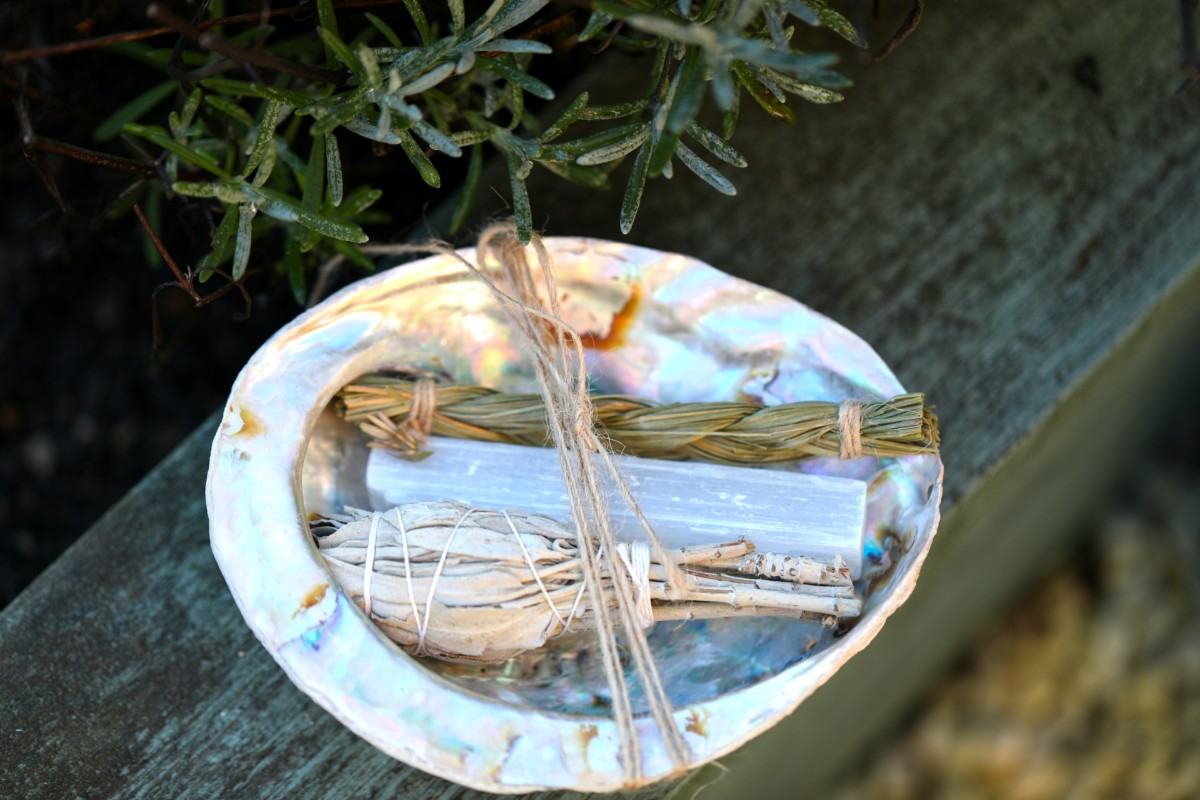The use of herbs and plant materials for spiritual and healing purposes has been a part of human culture for thousands of years. Two such materials that are widely used in modern times are sage and Palo Santo. Sage and Palo Santo have been used in traditional rituals and ceremonies for centuries, and their popularity has grown in recent years due to their perceived cleansing and healing properties. Let us explore the history and differences between sage and Palo Santo, their uses, how to ethically source them, and more.
The History of Sage and Palo Santo
Sage has been used by indigenous peoples of North America for thousands of years. It is believed to have cleansing and healing properties. Sage has been used in rituals and ceremonies to purify spaces, objects, and individuals. It is typically burned as a bundle of dried leaves, known as a smudge stick, to release its aromatic smoke. Native American tribes, including the Lakota, Navajo, and Cherokee, have used sage in their spiritual practices for centuries. It has also been used in traditional Chinese medicine and in ancient Egyptian medicine.
Palo Santo, also known as “Holy Wood,” is native to South America, particularly the Andean region. It has been used by indigenous peoples for centuries in spiritual ceremonies and healing rituals. Palo Santo is harvested from the branches of the tree and is typically burned as incense. The smoke is believed to have cleansing and healing properties, and it is used to enhance energy, purify spaces and ward off negative energy.
The Science Behind them
The use of sage and Palo Santo for spiritual and healing purposes is based on anecdotal evidence and traditional knowledge. There is limited scientific research on the properties of these materials. However some studies have suggested that they may have antimicrobial properties.
A study published in the Journal of Ethnopharmacology found that sage smoke reduced airborne bacteria by 94 percent. Another study published in the same journal found that Palo Santo smoke had antimicrobial properties and was effective against several types of bacteria.
On another note, the use of both sage and Palo Santo is powerful for the people that use them. And for spiritual practices regardless of what science says, it will be useful as it is also a part of culture and tradition.
Some animal studies also suggest that both sage and Palo Santo have a positive effect on stress relief and pain relief.
It is important to note that the the plants does not replace medical treatment. Always consult your trusted health care professional before use.

Sage vs. Palo Santo
The plants are both used for spiritual and healing purposes, but they have some differences in terms of their properties and uses.
Sage has a strong, earthy scent and is believed to have cleansing and purifying properties. It is typically used to clear negative energy and promote positive energy. Sage is often used in rituals and ceremonies to purify spaces, objects, and individuals.
Palo Santo has a sweet, aromatic scent and is believed to have cleansing and healing properties. It is typically used to ward off negative energy and attract and enhance positive energy. The Holy Wood is often used in spiritual ceremonies and healing rituals to purify spaces and promote relaxation. On top of that, it is also used for stress relief and pain relief in some cultures.
Smudging and Cleansing
The act of burning sage or Palo Santo is commonly referred to as smudging. Smudging is a traditional practice used to purify spaces, objects, and individuals of negative energy and promote positive energy. It is believed to have spiritual and healing properties and it is used by many cultures and traditions around the world.
Smudging can be used to cleanse a new home, an object, or a person of negative energy or to clear a space of unwanted energy. It can also be used to promote relaxation, calmness, and mental clarity.
When smudging, it is important to be respectful and mindful of the practice and its cultural significance. It is also important to ensure that the space is well-ventilated and that the smoke is not inhaled excessively.
Setting an intention before smudging with sage and Palo Santo can help to focus your energy and create a specific atmosphere or energy in your space. Before beginning your smudging ritual, take a few deep breaths and center yourself. Close your eyes and focus on your breath, allowing yourself to become fully present in the moment. Think about the reason for your smudging ritual and what energy you want to create or release. Your intention could be anything from clearing negative energy from your space/object/person, to inviting positivity and abundance into your life. Say your intention out loud as you are smudging.
After your smudging ritual is complete, take a moment to express gratitude for the positive energy you have created. Thank the universe, or any higher power you believe in, for the abundance and positivity that you have invited into your life.
How to use Sage
- Make sure you open windows and doors before your smudging ceremony. This will create a nice air flow for the smoke to leave with any negative unwanted energy.
- Light one end of the smudge stick with a match or lighter. Let it catch fire for around 30 seconds before you blow it out and it begins to smolder.
- Hold the smudge stick over a fireproof bowl, like a ceramic bowl or abalone shell, to catch any ash that may fall.
- Use a feather or your hand to waft the smoke around the room. You can also do it over the object or person you wish to cleanse. Continue for a few seconds for each part you’re cleansing.
- When you’re done, put out the smoke by gently pressing the sage bundle down into the fireproof bowl until it stops.

How to use Palo Santo
Palo Santo can be used in an essential oil or as a resin, but below is how you will use the actual stick.
- Hold one end of the palo santo stick over a flame until it begins to smolder. It is beneficial to hold the stick at a 45 degree angle. Allow the stick to burn for 30 seconds before blowing it out.
- Hold the smoldering stick over a fireproof bowl, like a ceramic bowl or abalone shell, to catch any ash that may fall.
- Use a feather or your hand to waft the smoke around the room. You can also do it over the object or person you wish to cleanse.
Both sage and palo santo can also be used in combination with other herbs or materials, such as sweetgrass, lavender, or rose petals, to enhance their properties or create a specific energy or atmosphere. Another hot tip is to add crystals and other spiritual items to the ceremony to enhance the intention and energizing properties.
How to Combine them
Interestingly, many people find that burning both sage and Palo Santo in combination can create a unique and powerful energy that enhances the smudging and cleansing properties of both materials.
When burning them together, it is important to ensure that the space is well-ventilated and that the smoke is not inhaled excessively. This will also ensure the negative energy to leave your space.
To burn sage and Palo Santo together, you can simply light both materials and hold them together, allowing the smoke to blend and waft around the space or object you wish to cleanse. Alternatively, you can burn them separately and alternate between the two, depending on your preferences and intentions. If you want to burn them separately, most people would recommend cleansing your space with sage first. Then, you’ll burn the Palo Santo for positive energy and additional healing.
Combine them with Other Plants And Herbs
In addition, combining sage and Palo Santo with other herbs or materials can create a unique and powerful energy that enhances their smudging, cleansing and healing properties. Here are some tips on how to combine them with other plants and herbs:
- Select herbs or materials that resonate with your intention or the energy you want to create. Some popular options include sweetgrass, lavender, rose petals, cedar, mugwort, and frankincense. For example, lavender is commonly used for relaxation. In addition, frankincense will be used for stress relief and anxiety relief.
- If using loose herbs or materials, you can tie them together into a bundle or braid them to create a smudge stick. You can also sprinkle them on top of burning sage or Palo Santo to create a unique scent and energy.
- As you smudge with your combination of materials, focus on your intention and visualize the energy you want to create or release. You can also recite a mantra or affirmation to help ground your intention and focus your energy.

How to Ethically and Sustainably Source Them
Ethical and sustainable sourcing of Palo Santo and sage, or any other plants and herbs, is important to ensure that the materials are harvested and processed in a way that respects the environment, local communities, and cultural traditions.
They can be found in many specialty stores, health food stores, and online retailers. Many retailers now offer certified organic or fair-trade options for sage and Palo Santo. That ensures that the materials were harvested and processed using sustainable and ethical practices. It is also important to be mindful of cultural appropriation. Choose reputable sources that respect and honor the cultural significance of these materials.
Many indigenous communities in Central and South America have been using Palo Santo and sage for centuries. They have a deep connection to these materials. Look for companies that work with indigenous communities to sustainably harvest and process these materials and support their livelihoods.
If you are unable to find ethically and sustainably sourced Palo Santo or sage, consider using alternatives. These can be cedar, sweetgrass, or lavender, which also have smudging and cleansing properties.
By being mindful of the sourcing and production of Palo Santo and sage, we can ensure that these materials continue to be available for future generations. And that their cultural significance and ecological value are respected and honored.
